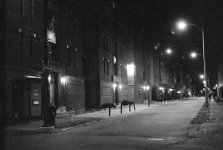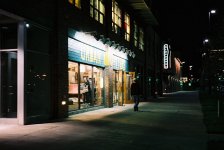Thanks, gang! 🙂
Thanks, gang!
🙂
Wow, three pages of responses!
I do appreciate all of the comments, examples, and advice, even the {d-word} ones.
A few things I have learned from comparing this session with the last session ...
1. The Mamiya lens shows significantly less astigmatism than the GIII when wide open.
2. The Canon lens is less susceptible to internal reflections and UFOs.
3. The Fuji film is far better for shooting in this kind of light than the Walgreens/Agfa I was trying out on the first one.
I'm going to kind of reply to all of this all mixed up ...
Have you thought about a tripod? You can then make longer exposures.
That's one thing I've been avoiding, I admit.
The consensus here seems to be to use a combination of longer exposures, smaller f-stops, and maybe even slower film. In order to do that, a tripod may be a necessary evil.
A lens hood would help eliminate some flares, like the "swoosh" in #1.
Yes, and that's cheap enough so I can try that on my next attempt.
🙂
Other than that, I think that it's hard to get a high quality night picture if you want to avoid a tripod. You either have to use a wide aperture, which increases optical distortion, or a fast film, which increases grain.
I guess with this scene, I'm pushing things about as far as they can be pushed. The things I like about the vintage rangefinder is the fast sharp lens and the smooth shutter. I can usually get away handholding at 1/15 if I concentrate.
However, we all have our limits.
You aren't going to like this, but...
You are most correct!
🙂
Nothing beats digital for shooting challenging scenes.
The ability to immediately see the results, yes, may be an advantage, but ...
Digital? OMDB!
🙂
A tripod/support would help a great deal, I think.
Another vote for Tripod.
🙂
An alternative approach is to see how these shots look in black-and-white. I sometimes find that when I take what I think will be a really cool shot in color and it doesn't work, I convert it to black-and-white and the shot I originally saw jumps out at me.
Hmmmm ... Ok, I'll bite. I've attached a quickie channel mixer conversion below.
I really think the color makes this shot, at least the way I see it in real life. There's the subtle coloration of the cooler lights in the foreground (mercury?) and the warmer lights in the background (sodium?) and on the buildings (incandescent) that I wanted to capture. You can just barely see the cooler light on the pavement in the very front.
You have gotta be kidding. For night scenes like this dynamic range is crucial and color negs or BW film will whip digital or color slides at this one area.
I do have to agree with this. I'm blowing away the dynamic range of the film no matter what I do here. The one taken at 1/30 wide open still has some detail in the shadows. The 1/15 at about 2.8 pulls the shadows into the mud, but the lights are still way blown out, at or close to 255 on all channels of the color sampler. If I had another couple of stops worth of dynamic range, I would take it!
Hey, might this be a candidate for a multiple-exposure HDR type thing?
A tripod and slightly smaller apertures and proper metering might help,
and a hood or a carefully placed hand might help with flare.
take a tripod. Borrow one if you have none.
Four votes tripod, three votes hood. The tribe has spoken!
🙂
Also, what i seem to see on the third image especially, is that your scanning/displaying is not consistent with your exposure idea.
Meaning, you expose in a way that the shadows go dark, but then, you bring them up / brighten them when you scan or after scanning.
Therefore the shadows still have no details on the third image but they do have lots of noise/grain/color shifts.
What I got is not consistent with what I saw. I exposed the best I could, by matching the needle closely (it was wide open at 1/30 with still maybe 1/4 stop underexposure).
These are lab scans. (Fuji Frontier 550.) Tomorrow I'll try re-scanning and see if that makes any difference. I really did not tweak things that much.
My suggestion would be: either measure the light differently, and give the film more exposure,
Yes, more exposure. That means ... {ok, in unison now} ... TRIPOD!
🙂
But right now it looks, that both the metering of the scene AND the image processing/scanning is just left to the artifficial intelligense. I.e. camera autoexposure, scanner auto brightness/contrast.
The Mamiya SD is manual, match-needle. No auto mode.
However, these scans are right from the lab, all auto.
Night scenes are the most difficult lighting and way over the guesswork capability of any autoexposure device.
Ya know, usually I can get good night shots. I think I have a good feel for what the final photo will look like. What's so frustrating with this one is that what I saw is not what I got. It's very abstract. Very hard to explain. What you see in the photos here is not what I saw!
if you want normal colours in the shot, either get tungsten balanced film or have a cooling filter and longer ?(much longer) exposures. Again, the tripod is necessary.
Where blue light is scarce, there's nothing else to do than to cut on the red side.
I do see the point here, and yes, it might be worth trying a filter. (Do they even make something like a 800 color negative film balanced for tungsten in 35mm?)
However, I really don't think the colors are that far off. It just needs more cowbell! Uh, I mean more blue in the foreground.
🙂
If you look at the fire hydrant in the foreground, you can see how it's lit by the cool light above, and the warmer light from the building and down the block. The dark green foliage and awnings look very close to the way I saw them, actually.
Also to comment on Tuolumne's point, how the heck can you peer at a small screen on the back of a camera and be sure that you have achieved proper focus and are free of the weird light effects? That's one of the things I don't get about digital cameras --it's very hard to make any sort of critical evaluation of an image based on the LCD screen.
There's a lot of things I don't get about digital cameras.
🙂
And a tripod is probably best for the purpose, though it does slow things down considerably if you need to beat a hasty retreat.
Uh, it's not *THAT* bad a neighborhood.
🙂
but a mild star filter can add some pizzazz to streetlights, etc.
Gumby - actually stopping down to f/16 or such WILL act like a "mild star effect" on the strong highlights without distorting the rest of the image
Actually, at least on the GIII, you don't need to get it down to 16. 5.6 or so will do it as shown here:
http://www.rangefinderforum.com/photopost/showphoto.php?photo=7821
The only problem with the tungsten film/filter suggestion is the street lights are not tungsten. Use daylight and come to peace with whatever color the sodium vapor gives you.
The thing is, looking on the histograms, the blue is still the weakest of the three channels. It's MUCH better than with the W/A, but still weak. I think there is merit to bringing the three channels closer together.
Give up on normal colors and shoot instead for something you think is beautiful. At night our minds constantly correct for color anyway; as long as you like it
Agree. However, I can usually do a night shot and get the colors fairly close to what I saw at the time. This one is especially challenging.
I wonder what exactly you consider a "Winner".
One that expresses the feelings I had when I viewed the scene and took the shot.
In these pictures, the scene(s) suffer from too much contrast from street level up to the roofs.
It's terribly contrasty. From the black cat in the coal bin to the surface of the sun! Zone minus-1 through Zone infinity-minus-1.
🙂
The scene is compositionally bland and I would not take it.
Then don't.
🙂
But you might enjoy the view (which no medium can replicate; our eyes work through many more stops all at once).
What happened here, obviously, is I failed to express the feelings I had at the time of the exposure. What I saw and what I felt is not what was captured.
🙁
Moreover you did tilt the camera up for convergence which annoys me.
Yes, I did tilt it slightly upward, but to compose and get the scene into the frame.
I'm about 5'6 tall, meaning eye level will be about 5'3 and lens level will be about 5'2. Other than standing on something ... hmmmm ... behind me, where the street ends in a T intersection, is a gated walk upward to a courtyard by two rows of apartments. Maybe I could shoot from there? It may be locked, I don't know.
Say what? (Isn't that three words, not one?)
🙂
Thanks DMR for the thread, and it stayed on topic for the most part
You're very welcome.
And, thanks for the answers and discussion. I guess I'm just a bit overconfident in taking a good night shot. Both the Mamiya and the GIII are great for most night scenes, and the Fuji 400 and 800 usually give very clean, smooth, and predictable results.
I'm also attaching one I shot from the same roll not 30 minutes before. Clean and smooth. Yes, it's very high contrast, lights are close to being blown and shadows on the right sidewalk and street are mud, but it's what I saw.
Thanks again, gang.
🙂



